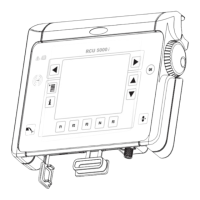111
EN
End of welding
Guideline values
Current drop
The current drop parameter determines the speed at which the short circuit current con-
trol changes to voltage control.
0 = flat drop (soft arc, tending towards instability)
65535 = steep drop (hard, stable arc)
Current rise
The current rise parameter determines the speed at which the welding current increases
for the duration of the short circuit.
0 = steep rise (hard, stable arc)
65535 = flat rise (soft arc, tending towards instability)
Burn-back time
The burn-back time [s] can be saved for each characteristic point.
0.00 = minimum burn back time (risk of wire sticking to weld pool)
0.40 = maximum burn back time (risk of wire sticking to contact tube)
Burn-back pulsing current
Strength of current pulse [A], set at end of welding. The current pulse when welding stops
produces a defined detachment of the last drop (a wire end with small drop is a precon-
dition for good ignition). The parameter value must be greater than 0, otherwise there will
be no current pulse.
0 = no current pulse at end of welding
max. = max. current pulse at end of welding (depends on the power source)
Burn-off pulse time
The length of time [ms] the current pulse is active at end of welding.
0 = no current pulse at end of welding
50 = max. duration for the current pulse when welding stops
Guideline value for material
The guideline value for the material strength [mm] is normally determined by trial and er-
ror or by performing a test weld
Voltage guideline value
The voltage guideline value [V] is normally determined by trial and error or by performing
a test weld. On power sources TS 4000/5000 and TPS 2700/4000/5000, the voltage
guideline value corresponds to the voltage on the contact tube.
Current guideline value
In MIG/MAG manual welding the current guideline value [A] is normally determined by tri-
al and error or by performing a test weld.
Type of arc
For the best characteristic, keep the arc type that occurs during the test weld (short, glob-
ular, long or spray arc).

